
Early Childhood
This month EC’s theme was Winter and Arctic Animals. We read many great books, The Snowy Day, Three Little Kittens, Polar Bears, Winter is Here, A Long Winter’s Nap, The Mitten and Snow. We discussed the many different types of clothes we wear in the winter and activities that we can only do in the Winter. We sang new alphabet and letter songs, and several new finger plays, Snowflake and two versions of 5 Little Snowmen. We learned about different animals that love the snow, penguins and polar bears.
We are working on correct letter and number formation with HandWriting Without Tears and even tried guided drawing of penguins and snowmen.
Kindergarten
Kindergarten has had a great month learning about winter and animals that live in cold environments. We have been practicing segmenting our words as well as using those sounds in our writing. We have also explored the world of 3D shapes and hunted for 3D shapes in our school. We are very excited to be celebrating the 100th Day of school on Tuesday. It is a major milestone in kindergarten and something that they look forward to everyday.
Tips and Tricks:
Every time you read with your child, be sure to ask questions before, during and after reading. While asking your AFTER reading questions have your child open the book and prove their answer. Ask them HOW they know the answer they provide. Finding the answers within a text is a great skill for readers to master.
First Grade
First grade has been learning about the solar system. We had fun creating the moon phases using Oreo cookies. We created the solar system. We made our own rocket and wrote about a special journey into space.
Second Grade
Second grade learners are finishing up addition with and without regrouping and will be starting subtraction. They are also finishing up the polar biome and will be presenting on an arctic animal. In social studies, second graders have also continued to enjoy learning about winter celebrations around the world.
Third Grade
Reading and EL
The students have been learning about non-fiction text structure. The different types of non-fiction text structure include: problem and solution, cause and effect, compare / contrast, description and sequence. Understanding text structure and text features are important because it helps the students have a purpose when they are reading. The readers are able to summarize the text by using the text structure as a guide. After reading, the students use graphic organizers to map out their ideas from the text. As they are reading, they think about how the text is organized and look for important words to determine what type of text they are reading. For example, the wind speed increased (cause) so the sailboat moved faster (effect). Another example is when we compare and contrast different nouns such as fish and whales. When we compare the two, both the whales and fish can live in the water. When we contrast the two, whales need to go to the surface to breathe air. However, fish have gills and can stay underwater to breathe.
Specials
Kindergarten and First Grade parents ~ mark your calendars for Thursday, March 5th. That’s when the Kindergartens and first grades will present their music programs. Kindergarten’s “Sounds a Little Fishy to Me,” music program will begin at 6:00 P.M. and first grade’s “Down at the Beach,” program will begin at 7:00 P.M. that same evening. Watch for more information coming soon!
In PE we are starting our Hockey tournament with grades 2-5. This will be the conclusion of our 4 week hockey unit. Kindergarten and First graders will be working on their hockey skills while playing modified games such as line hockey and six goal hockey. Still to come for PE students will be participating in Paddleball, Baseball, as well as some kickball and bean bag type games.
In Health, the students have concluded their bullying projects and now have been discussing the effect of smoking on the body. Upon completion of our anti-smoking unit the students will dive deeper into the function and structure of the body.

